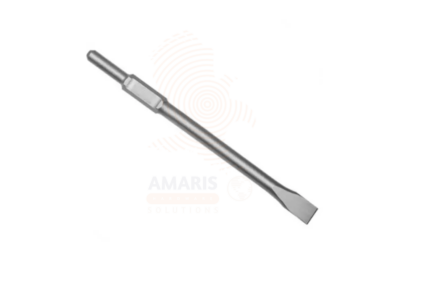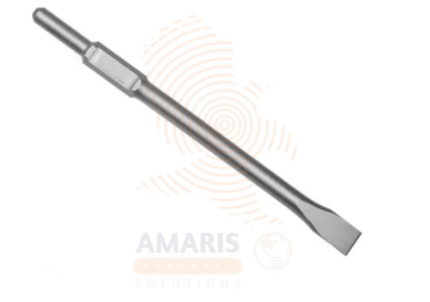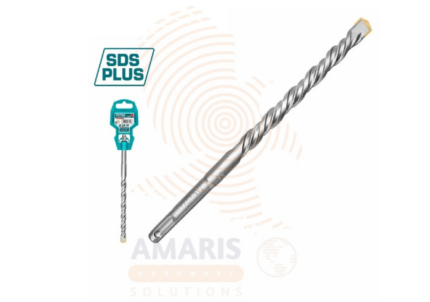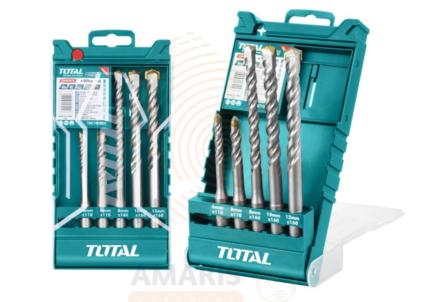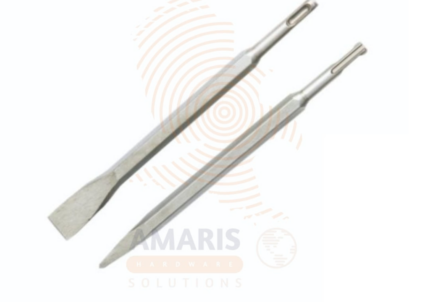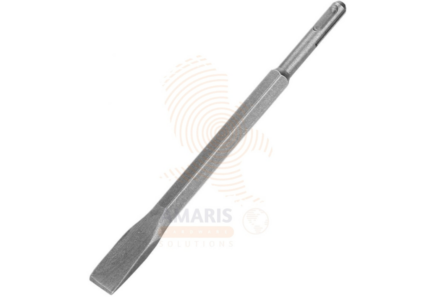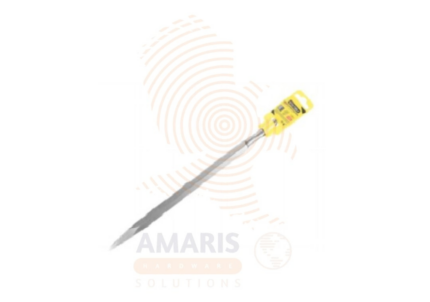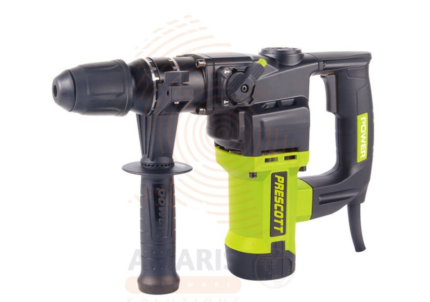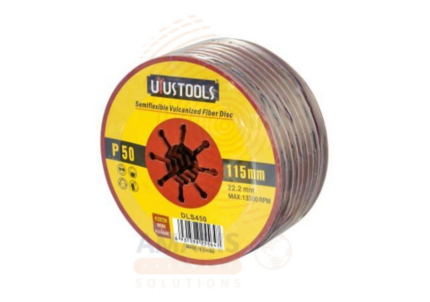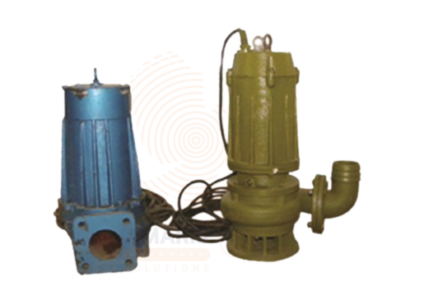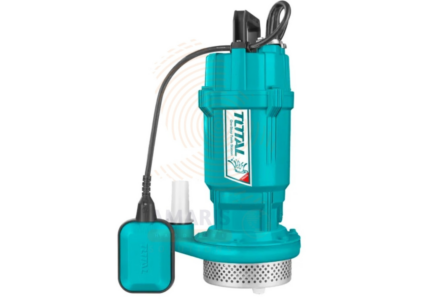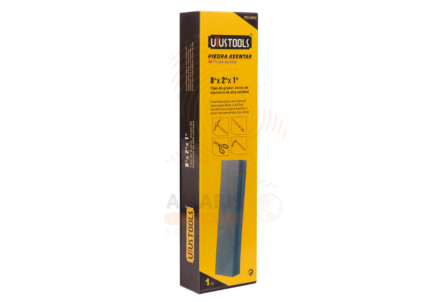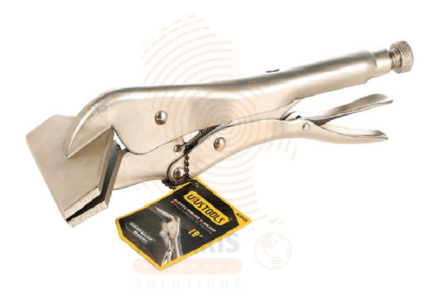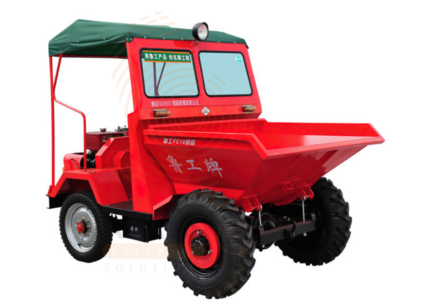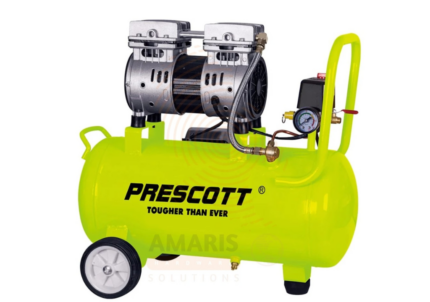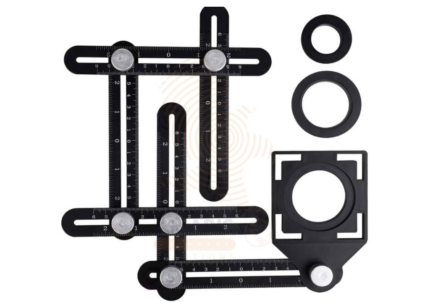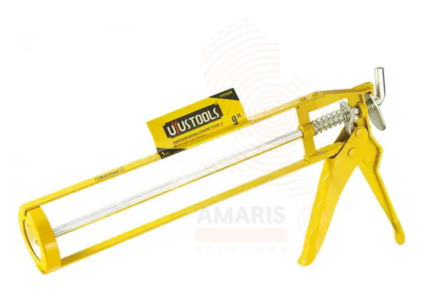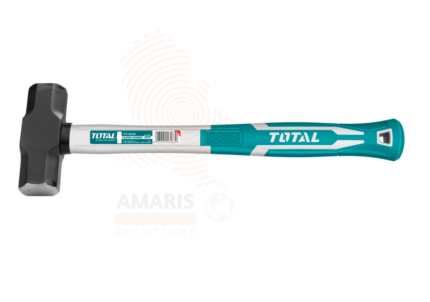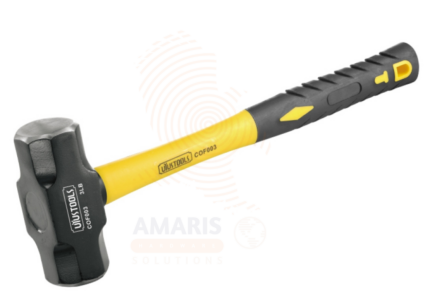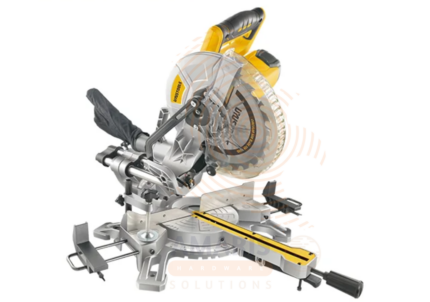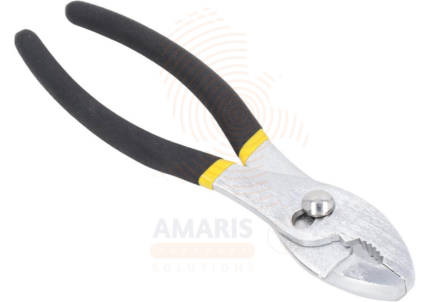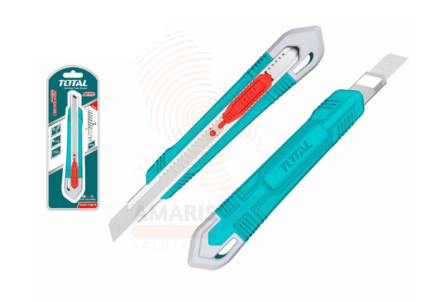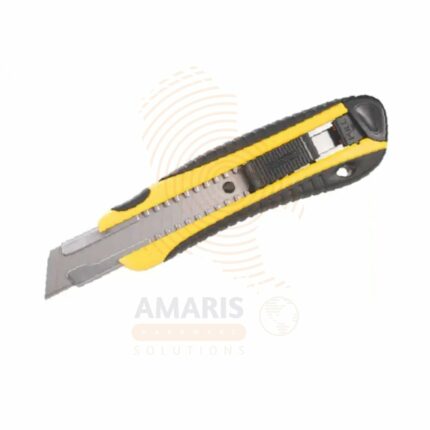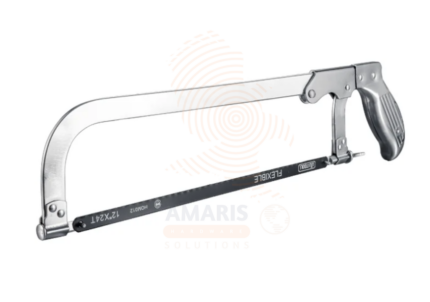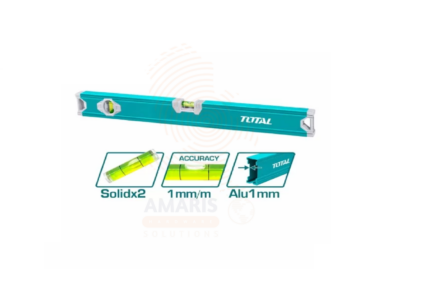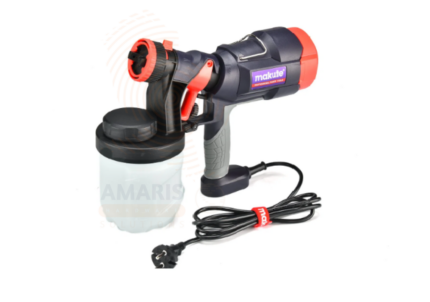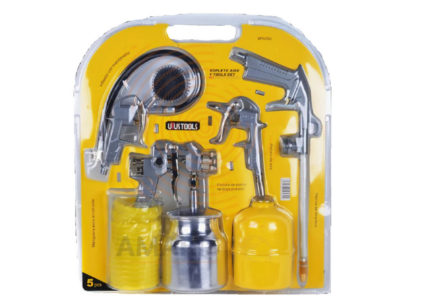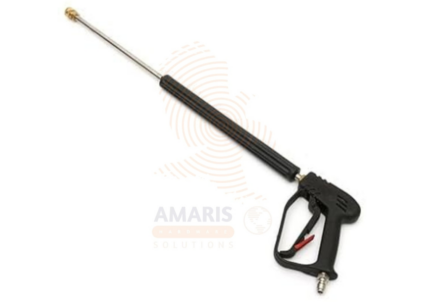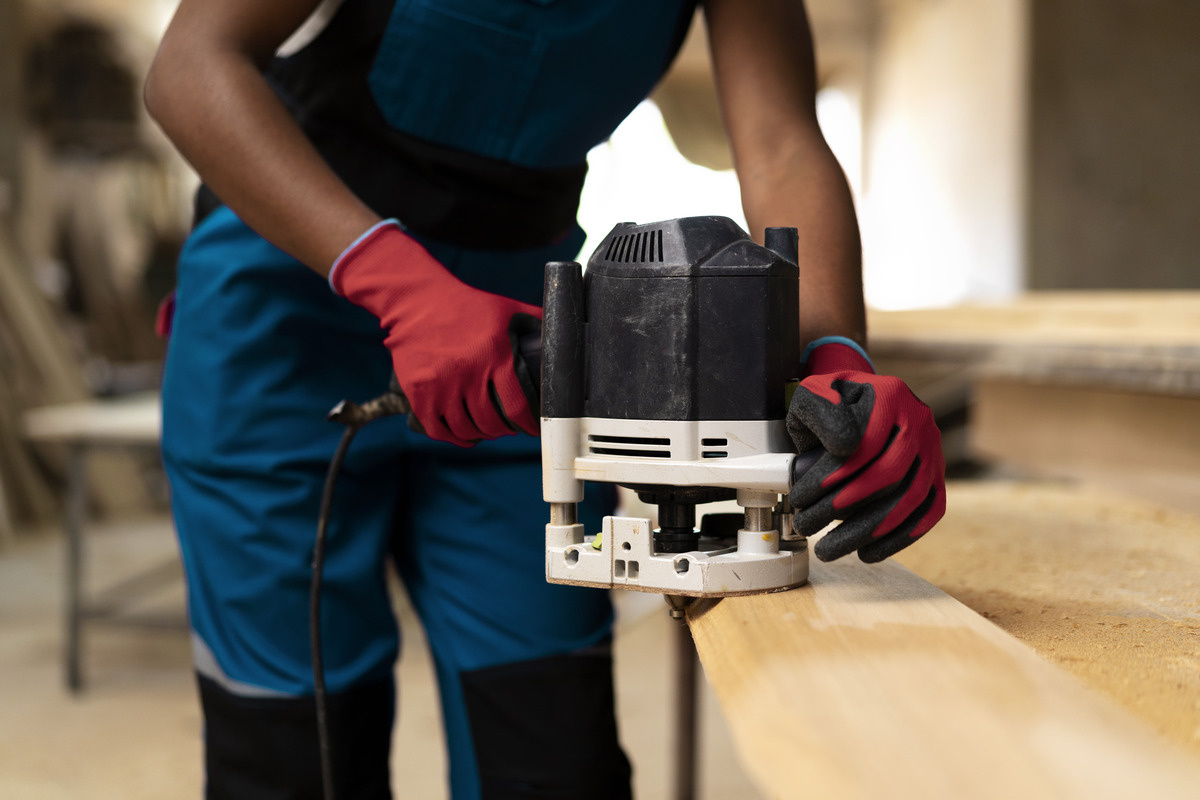
SDS – Max Stone Pointed Chisel
An SDS - Max Stone Pointed Chisel is a specialized masonry tool designed for use with power tools equipped with SDS-MAX (Slotted Drive System) chucks. It features a pointed, wedge-shaped metal blade with a durable carbide or hardened steel tip. This chisel is specifically crafted for efficient and precise material removal in hard surfaces like stone, concrete, or masonry. The pointed shape allows for accurate chiseling, carving, or breaking of hard materials during construction or demolition projects. The SDS-MAX system ensures quick and secure attachment to compatible power tools, enhancing the chisel's performance and ease of use.
SDS – PH65 Stone Flat Chisel
The SDS - PH65 Stone Flat Chisel is a high-performance chisel accessory engineered for use with heavy-duty demolition hammers such as the Hitachi PH65 series. Made from hardened steel, this flat chisel features a wide blade designed for precision scaling, shaping, and removal of stone, concrete, and masonry surfaces. Its SDS-compatible shank ensures a secure fit in demolition tools, delivering maximum impact transfer during tough demolition and surface preparation tasks. Ideal for professional contractors and masons, the SDS - PH65 Flat Chisel provides efficient material removal with excellent control and durability.
SDS – PH65 Stone Pointed Chisel
The SDS - PH65 Stone Pointed Chisel is a durable, precision-forged tool designed for heavy-duty demolition applications. Specifically compatible with PH65-class demolition hammers, this chisel features a pointed tip that delivers focused impact energy for breaking and penetrating dense materials such as concrete, masonry, stone, and brick. Built from hardened steel, it offers superior wear resistance and impact strength, making it a reliable choice for demolition, excavation, and renovation work that requires accuracy and control.
SDS Plus Hammer Drill
An SDS Plus Hammer Drill is a versatile power tool designed for drilling into various materials, particularly masonry and concrete. The term "SDS" stands for Slotted Drive System, which refers to the special chuck mechanism used in these drills. The SDS Plus system allows for quick and secure interchangeability of drill bits without the need for additional tools. The hammering action, combined with the rotary motion, enables efficient drilling through tough surfaces by breaking up the material as the drill bit rotates. This type of hammer drill is commonly used in construction, carpentry, and other applications where heavy-duty drilling is required.
SDS Plus Hammer Drill Bits Set
A SDS PLUS Hammer Drill Bits Set is a collection of specialized drill bits designed for use with rotary hammer drills that feature the SDS PLUS (Slotted Drive System) chuck system. These drill bits are characterized by their unique shank design, which allows for efficient power transmission and enhanced drilling performance in masonry, concrete, and other hard materials. The SDS PLUS system includes a spring-loaded chuck mechanism that enables quick and secure bit changes without the need for additional tools. SDS PLUS Hammer Drill Bits are commonly used in construction and masonry applications where traditional drill bits may be less effective.
SDS Plus Stone Chisel Set
A SDS Plus Stone Chisel Set for hardware use typically refers to a set of two chisels designed for use with tools equipped with SDS-PLUS shanks. SDS-PLUS is a type of chuck system commonly used in rotary hammer drills, providing a secure and quick way to change drill bits and accessories. The stone chisels in this set are specifically crafted for working with hard materials like stone, concrete, or masonry. These chisels are essential tools for various hardware applications, including construction and renovation projects, where precise and efficient material removal is required. The set usually includes different sizes or shapes of chisels to accommodate various tasks and project requirements.
SDS Plus Stone Flat Chisel
An SDS Plus Stone Flat Chisel is a specialized tool designed for use with SDS-PLUS rotary hammer drills. It is a flat-edged chisel specifically crafted for masonry and stone applications. The SDS-PLUS shank refers to the type of chuck connection that allows for quick and secure tool changes in compatible rotary hammer drills. The flat chisel design is ideal for tasks such as chipping, carving, and shaping stone or masonry surfaces. This tool is commonly used in construction and renovation projects where precision and efficiency in working with hard materials are essential.
SDS Plus Stone Pointed Chisel
An SDS Plus Stone Pointed Chisel is a specialized masonry tool designed for use with rotary hammer drills that feature the SDS-PLUS chuck system. This chisel has a pointed tip specifically crafted for effective and precise material removal in stonework, concrete, or similar hard surfaces. The SDS-PLUS system allows for quick and secure attachment of the chisel to the drill, ensuring efficient chiseling and reducing the likelihood of slippage during operation. The stone pointed chisel is commonly employed in tasks such as carving, shaping, or breaking hard materials in construction and masonry applications.
SDS Rotary Hammer – 3 Operation Modes Hammering, With Rotation
A SDS Rotary Hammer – 3 Operation Modes Hammering, With Rotation, is a versatile power tool designed for drilling into hard materials such as concrete, masonry, and stone. The SDS (Special Direct System) refers to the type of chuck system it uses, which allows for quick and easy changing of drill bits without the need for additional tools.
The three operation modes typically include:
- Drilling with Rotation (or Rotary Drilling): In this mode, the tool functions like a traditional drill, rotating the drill bit to bore holes into various materials.
- Hammering: In this mode, the tool delivers rapid, short, and powerful hammer blows without rotation. This is particularly effective for breaking through tough materials like concrete.
- Hammering with Rotation (or Hammer Drill): This mode combines the rotational drilling action with the hammering function, making it ideal for drilling into hard materials where both impact and rotation are necessary.
SDS Rotary Hammer Steel Set
A SDS Rotary Hammer Steel Set typically refers to a collection of four pieces of drill bits or chisels designed for use with a rotary hammer that features an SDS (Slotted Drive System) chuck. The SDS system allows for easy and quick bit changes without the need for additional tools. These sets are commonly used in construction and masonry work, where rotary hammers are employed to drill into or chisel through tough materials like concrete or stone. The set may include various types of drill bits or chisels, each designed for specific applications, providing versatility and efficiency in different tasks.
Semi-flexible Vulcanized Fiber Disc
A Semi-flexible Vulcanized Fiber Disc is a type of abrasive tool used in various applications, such as metalworking and surface preparation. It is constructed from vulcanized fiber material, which is a dense and rigid composite made by impregnating layers of paper with resin and subjecting them to a curing process. The term "semi flexible" indicates that the disc possesses a degree of flexibility, allowing it to conform to contours and irregularities on the work surface while maintaining a certain level of rigidity.
The vulcanization process involves the application of heat and pressure to the fiber material, resulting in enhanced durability, strength, and resistance to wear and tear. These discs are commonly used for tasks like grinding, deburring, and polishing, providing efficient material removal and surface finishing. Semi flexible vulcanized fiber discs are valued for their versatility, combining the strength of rigid abrasives with some flexibility for improved adaptability during various industrial and manufacturing processes.
Set Hex Key
A Set Hex Key, also known as Allen wrenches, typically consists of a collection of ten individual tools, each featuring a hexagonal-shaped tip at one end. These hex keys are used for turning screws and bolts with hexagonal sockets. The set usually includes keys of various sizes, allowing users to choose the appropriate tool for different applications. Hex keys are commonly used in tasks involving furniture assembly, bicycle maintenance, automotive repairs, and various other mechanical or DIY projects where hexagonal fasteners are prevalent. The set may be made of durable materials such as steel or alloy, providing strength and longevity for repeated use.
Sewage Pump
A sewage pump is a submersible pump designed specifically to move wastewater and solid waste from one location to another, typically from a building’s sewage basin to a septic tank or sewer system. Engineered to handle solids-laden liquids, it is built with corrosion-resistant materials and robust impellers capable of processing human waste, sludge, and debris. Sewage pumps are commonly used in residential, commercial, and industrial sanitation systems, particularly where gravity flow is not possible. They are essential in managing waste efficiently, reducing health risks, and maintaining hygienic conditions.
Sewage submersible pump
A sewage submersible pump is a specialized type of pump designed for the efficient and reliable transfer of wastewater, sewage, or other contaminated fluids from one location to another. Unlike traditional pumps that are installed above ground, sewage submersible pumps are designed to be submerged in the fluid they are pumping. This submersible design allows the pump to operate efficiently in challenging environments, such as sewage systems, septic tanks, or other applications where the fluid may contain solids or debris.
These pumps are typically sealed to prevent water or sewage from entering the motor and other internal components. They often feature robust construction and materials to withstand the corrosive and abrasive nature of sewage. Sewage submersible pumps play a crucial role in wastewater management, helping to transport sewage from homes, businesses, and industrial facilities to treatment plants or disposal sites.
Sharpening Stone
A sharpening stone is a tool or abrasive surface used for the process of sharpening the edges of cutting tools, knives, or other blades. Typically made from natural or synthetic materials with varying levels of grit, sharpening stones are used to remove material from the blade, creating a finer and sharper edge. The process involves sliding the blade across the surface of the stone in a controlled manner to achieve the desired sharpness.
Side Dumper
A side dumper is a heavy-duty trailer or hauling unit designed to unload materials by tipping its container to the side rather than the rear. Commonly used in construction, mining, agriculture, and waste management, the side dumper is engineered for fast, stable unloading of bulk materials such as soil, gravel, sand, rocks, and agricultural produce. Its side-tipping mechanism minimizes the risk of tipping over compared to rear dumpers, especially on uneven terrain. Side dumpers increase productivity by enabling quick unloading and reducing turnaround times in high-volume material handling operations.
Silent Air Compressor
A silent air compressor is a device that generates compressed air with minimal noise emission during operation. Unlike traditional air compressors that can produce significant noise levels, silent air compressors are designed with sound reduction features to create a quieter working environment. These compressors are often employed in settings where low noise levels are crucial, such as in workshops, laboratories, or residential areas, allowing for more comfortable and less disruptive use.
Six Sided Angle Measuring Tool
A Six Sided Angle Measuring Tool, commonly known as a hexagonal protractor, is a geometric instrument with six equal sides and six internal angles, each measuring 120 degrees. This tool is specifically designed to facilitate the measurement and drawing of angles in various applications, such as geometry and engineering. The angles are typically marked or calibrated along the edges, allowing users to accurately determine and replicate specific angular measurements during drafting or other precision tasks.
Skeleton Caulk Gun
A "skeleton caulk gun" refers to a type of caulk gun that features a skeletal or open-frame design. Unlike standard caulk guns, which have a solid body enclosing the caulk tube, a skeleton caulk gun has a minimalistic structure with an open frame that allows the user to see the caulk cartridge inside. This design provides better visibility of the caulk level, making it easier for the user to monitor and control the application of caulk. Skeleton caulk guns are commonly used in construction and home improvement projects for sealing joints and gaps with precision.
Sledge Hammer – Fiberglass Handle
A Sledge Hammer - Fiberglass Handle is a heavy-duty hand tool designed for tasks that require powerful striking force. The sledgehammer typically features a large, double-faced metal head, with one flat and one wedge-shaped side, mounted on a durable handle made of fiberglass. The fiberglass handle is chosen for its strength, durability, and resistance to wear and tear. This construction enhances the tool's overall efficiency and safety by providing a comfortable grip, reducing vibration, and minimizing the risk of handle breakage. The sledgehammer with a fiberglass handle is commonly used in construction, demolition, and other heavy-duty applications where substantial force is needed for tasks such as driving wedges, breaking concrete, or driving stakes.
Sliding Miter Saw
A sliding miter saw with a 255 mm blade refers to a power tool used in woodworking and carpentry for making accurate crosscuts, miter cuts, and bevel cuts in various materials, especially wood. The "255 mm" specification indicates the diameter of the circular saw blade that the tool accommodates.
The "sliding" feature distinguishes it from a standard miter saw by allowing the saw head to move forward and backward on rails. This sliding action increases the cutting capacity, enabling the tool to handle wider boards or panels. The combination of miter and bevel adjustments provides flexibility in cutting angles and bevels, making it a versatile tool for a range of applications. The 255 mm blade size typically suggests a balance between cutting capacity and portability, making it suitable for a variety of woodworking tasks.
Snap-off Blade Knife
A snap-off blade knife, also known as a snap blade or utility knife, is a cutting tool with a retractable and replaceable blade. The blade is typically segmented into multiple sections, allowing users to snap off a dull or damaged section to reveal a fresh, sharp edge. This design ensures a consistently sharp cutting surface without the need for manual sharpening. The retractable feature allows for safe storage and convenient adjustment of the blade length based on the cutting requirements. Snap-off blade knives are commonly used in various applications, including crafting, construction, and general-purpose cutting tasks.
Snap-Off Knife
A snap-off knife, also known as a utility knife or a snap blade knife, is a cutting tool with a retractable, segmented blade that can be easily replaced as it becomes dull. The blade is typically made up of multiple connected segments, allowing users to snap off the worn-out portion and expose a fresh, sharp edge. This design enables the user to maintain a sharp cutting edge without the need for manual sharpening. Snap-off knives are commonly used in various applications, such as crafting, construction, and general-purpose cutting tasks.
Sockets Set
A socket set typically refers to a collection of 24 individual sockets of varying sizes, designed for use with a compatible ratcheting wrench or socket wrench. These sets often include sockets in both metric and imperial measurements to accommodate different types of bolts and nuts. The set may also include additional accessories such as extension bars, universal joints, and a ratcheting handle. Socket sets are commonly used in automotive repair, machinery maintenance, construction, and various other applications where tightening or loosening nuts and bolts is required.
Solar Submersible Pump
A solar submersible pump is a water pumping system powered by solar energy, designed to operate while fully submerged in water. Commonly used in agricultural, domestic, and remote water supply applications, it draws power from solar panels to lift water from wells, boreholes, or other sources. It is highly efficient and environmentally friendly, making it ideal for off-grid or energy-scarce regions. Built with corrosion-resistant materials and often equipped with brushless DC motors, solar submersible pumps offer a sustainable solution to irrigation, livestock watering, and household water needs.
Speed Heat Gun
A speed heat gun is a versatile electric tool that emits a stream of hot air at variable temperatures and speeds, used for a wide range of industrial, construction, and household applications. With adjustable airflow and heat settings, it allows precise control for tasks like paint stripping, plastic welding, adhesive removal, and shrink wrapping. Designed with ergonomic grips and thermal protection, speed heat guns are essential for tasks requiring controlled heating without open flames.
Spirit Level
A spirit level, also known as a bubble level or simply a level, is a tool used in construction, carpentry, and other related fields to determine whether a surface is horizontal (level) or vertical (plumb). It typically consists of a rectangular or cylindrical body with a transparent tube filled with liquid. Inside the tube, there is a bubble, and the goal is to center this bubble between two marked lines or within a central vial. When the bubble is centered, the surface is considered level or plumb, providing a visual reference for ensuring accuracy in various construction and alignment tasks.
Spoke Shave
A spoke shave is a woodworking tool designed for shaping and smoothing curved surfaces on wood. It typically consists of a blade that can be adjusted and secured in a metal body with handles on each end. The blade is positioned at a low angle to the workpiece and can be used for various tasks such as shaping chair spindles, rounding edges, and refining curved surfaces. The tool is called a spoke shave because it is commonly used in shaping the spokes of wheels, but it is versatile and can be employed for a range of woodworking applications.
Spray Gun
A spray gun is a handheld device or tool that utilizes compressed air or other pressurized gases to atomize and propel liquid substances, typically paint, coatings, or other materials, onto a surface. This process allows for an even and controlled application of the substance, producing a fine mist or spray that covers the target area uniformly. Spray guns are commonly used in various industries, including automotive, woodworking, and manufacturing, for tasks such as painting, finishing, and coating surfaces efficiently and with precision.
Spray Gun & Air Tool Accessory Kit Set
A Spray Gun & Air Tool Accessory Kit Set typically refers to a package or bundle that includes five essential components or accessories designed to complement and enhance the functionality of spray guns and air tools. These kits are commonly used in various applications, such as automotive painting, woodworking, and other projects where spray painting or air-powered tools are employed. The specific contents of the kit may vary, but it often includes items such as different nozzle attachments, connectors, air hoses, and other accessories necessary for optimal performance and versatility with spray guns and air tools. The aim is to provide users with a comprehensive set of tools and accessories to meet their diverse needs in a convenient and cost-effective manner.
Spray Gun Lance
A spray gun lance is a component of a spraying system, typically used in applications such as agriculture, gardening, automotive refinishing, or industrial coatings. It is a long, slender extension attached to a spray gun, allowing the user to apply liquids, such as paint, pesticides, or cleaning solutions, from a distance. The spray gun lance directs the flow of the liquid and provides control over the application process, enabling precise and targeted spraying. It is a versatile tool used in various industries for efficient and uniform coating or treatment of surfaces.
Spring Clamp
A spring clamp is a tool designed for holding and securing objects together. It typically consists of two elongated arms joined at one end by a spring mechanism, which exerts force to keep the arms closed. The opposite ends of the arms often have gripping surfaces or jaws that can hold onto objects, allowing the clamp to be used for various applications such as woodworking, metalworking, or holding materials in place during gluing or assembly. The spring mechanism makes it easy to open and close the clamp, providing a quick and convenient way to secure items temporarily.
Spring Clamp – Dual Color
A spring clamp - dual color is a hand-operated clamping tool designed to provide quick, firm, and temporary holding pressure on materials. It features strong spring tension for gripping, typically used in woodworking, crafting, photography, and light-duty construction. The dual-color design enhances visibility and differentiates size or strength variants. Made with durable plastic or metal and pivoting jaws, it provides secure and non-marring clamping on uneven surfaces.
Square Cement Blender
A square cement blender typically refers to a piece of equipment used in construction and concrete-related applications. It is a machine designed to mix cement, sand, gravel, and water thoroughly to produce a uniform and homogenous mixture, commonly known as concrete. The "square" aspect of the term may refer to the shape of the blender's mixing drum or container.
In essence, a square cement blender is a construction tool utilized to efficiently combine and blend the essential components of concrete, facilitating the preparation of a consistent and workable material for various building projects.
Staples for Auto Gun
Staples for auto gun are U-shaped metal fasteners specifically designed for use with pneumatic or manual staple guns. These staples are used to secure materials such as fabric, wood, wire mesh, and insulation in construction, upholstery, carpentry, and packaging applications. They are made from galvanized or stainless steel to resist rust and provide strong holding power. Available in various crown widths and leg lengths, they offer consistent penetration and fastening performance in high-speed, repetitive tasks.
Steel Long Tape
A steel long tape is a measuring tool used in construction, surveying, and various other applications to accurately determine distances. It typically consists of a flexible, steel tape encased in a durable housing with a mechanism for easy winding and unwinding. The tape is marked with precise measurements, usually in feet or meters, allowing users to measure lengths with a high degree of accuracy. The steel construction provides durability and resistance to stretching, making it suitable for demanding outdoor environments. Steel long tapes are commonly used by professionals in fields such as carpentry, architecture, civil engineering, and land surveying.
Stone Crusher
A stone crusher is a heavy-duty machine designed to reduce large rocks into smaller stones, gravel, or rock dust for use in construction, road building, and other aggregate applications. These machines use mechanical force to break down stone material, typically through compression or impact. Stone crushers come in various types such as jaw crushers, cone crushers, impact crushers, and hammer crushers, each suited to specific crushing requirements. They are widely used in mining, quarrying, construction, and recycling industries to produce consistent aggregate sizes for foundations, concrete, asphalt, and more.


 Acrylic Sealants
Acrylic Sealants Construction Adhesives
Construction Adhesives Double-Sided Tape
Double-Sided Tape Duct Tape
Duct Tape Electrical Tape
Electrical Tape Epoxy & Resins
Epoxy & Resins Masking Tape
Masking Tape
 Automotive Wrenches & Socket Sets
Automotive Wrenches & Socket Sets Battery Chargers & Jump Starters
Battery Chargers & Jump Starters Car Jacks & Stands
Car Jacks & Stands Car Wash & Detailing Products
Car Wash & Detailing Products Diagnostic Tools
Diagnostic Tools Tire Inflators
Tire Inflators Vehicle Lighting
Vehicle Lighting Oil & Lubricants
Oil & Lubricants
 Adhesives & Sealants
Adhesives & Sealants Bricks & Blocks
Bricks & Blocks Cement & Concrete
Cement & Concrete Drywall & Plaster
Drywall & Plaster Flooring (Tiles, Wood, Laminate)
Flooring (Tiles, Wood, Laminate) Lumber & Plywood
Lumber & Plywood Paints, Primers & Coatings
Paints, Primers & Coatings Insulation Materials
Insulation Materials Roofing Materials
Roofing Materials
 Circuit Breakers
Circuit Breakers Electrical Cables & Wires
Electrical Cables & Wires Switches & Sockets
Switches & Sockets Fuses & Relays
Fuses & Relays Connectors & Terminals
Connectors & Terminals Electrical Boxes & Panels
Electrical Boxes & Panels Conduit & Fittings
Conduit & Fittings Lighting Fixtures & Bulbs
Lighting Fixtures & Bulbs Extension Cords & Power Strips
Extension Cords & Power Strips
 Anchors
Anchors Bolts
Bolts Clips & Clamps
Clips & Clamps Screws
Screws Nuts
Nuts Washers
Washers Rivets
Rivets Nails
Nails Threaded Rods
Threaded Rods
 Hammers
Hammers Measuring Tools (Tapes, Levels, Calipers)
Measuring Tools (Tapes, Levels, Calipers) Screwdrivers
Screwdrivers Pliers & Cutters
Pliers & Cutters Saws & Blades
Saws & Blades Chisels & Punches
Chisels & Punches Allen Keys & Hex Keys
Allen Keys & Hex Keys Ratchets & Socket Sets
Ratchets & Socket Sets Wrenches & Spanners
Wrenches & Spanners
 Power Tool Accessories (Blades, Bits, Discs)
Power Tool Accessories (Blades, Bits, Discs) Rotary Tools
Rotary Tools Saws (Circular, Jigsaw, Reciprocating)
Saws (Circular, Jigsaw, Reciprocating) Drills & Drivers
Drills & Drivers Grinders & Sanders
Grinders & Sanders Heat Guns
Heat Guns Nail Guns
Nail Guns Impact Wrenches
Impact Wrenches Batteries & Chargers
Batteries & Chargers
 Pipes & Fittings (PVC, Copper, PEX)
Pipes & Fittings (PVC, Copper, PEX) Plumbing Tools
Plumbing Tools Pumps & Motors
Pumps & Motors Sealants & Adhesives for Plumbing
Sealants & Adhesives for Plumbing Valves & Taps
Valves & Taps Water Heaters
Water Heaters Drainage Systems
Drainage Systems Faucets & Fixtures
Faucets & Fixtures Hoses & Tubing
Hoses & Tubing
 Hinges & Latches
Hinges & Latches Hooks & Brackets
Hooks & Brackets Window Hardware
Window Hardware Chains & Cables
Chains & Cables Casters & Wheels
Casters & Wheels Shelving & Storage Systems
Shelving & Storage Systems Door Handles & Locks
Door Handles & Locks Drawer Slides & Cabinet Hardware
Drawer Slides & Cabinet Hardware
 Personal Protective Equipment (PPE)
Personal Protective Equipment (PPE) Respirators & Masks
Respirators & Masks Safety Glasses
Safety Glasses Safes
Safes Security Cameras
Security Cameras Gloves
Gloves Helmets
Helmets Ear Protection
Ear Protection Fire Safety Equipment
Fire Safety Equipment Locks & Padlocks
Locks & Padlocks Motion Sensors & Alarms
Motion Sensors & Alarms
 Garden Fencing
Garden Fencing Garden Furniture Hardware
Garden Furniture Hardware Lawn Mowers
Lawn Mowers Trimmers & Edgers
Trimmers & Edgers Shovels & Spades
Shovels & Spades Rakes & Hoes
Rakes & Hoes Pruning Shears & Loppers
Pruning Shears & Loppers Watering Systems (Hoses, Sprinklers, Nozzles)
Watering Systems (Hoses, Sprinklers, Nozzles)
 Interior Paints
Interior Paints Paint Brushes & Rollers
Paint Brushes & Rollers Paint Strippers & Thinners
Paint Strippers & Thinners Paint Trays & Accessories
Paint Trays & Accessories Exterior Paints
Exterior Paints Spray Paints
Spray Paints Primers & Undercoats
Primers & Undercoats Varnishes & Stains
Varnishes & Stains
 Gaskets & Seals
Gaskets & Seals Hydraulic Fittings
Hydraulic Fittings Industrial Fasteners
Industrial Fasteners Industrial Hoses
Industrial Hoses Lubricants & Greases
Lubricants & Greases Metal Sheets & Bars
Metal Sheets & Bars Bearings & Bushings
Bearings & Bushings Belts & Pulleys
Belts & Pulleys
 HVAC Filters
HVAC Filters Insulation for HVAC
Insulation for HVAC Air Conditioners
Air Conditioners Refrigerants
Refrigerants Ventilation Ducts & Fittings
Ventilation Ducts & Fittings Thermostats & Controllers
Thermostats & Controllers Fans & Blowers
Fans & Blowers
 Pegboards & Hooks
Pegboards & Hooks Shelving Units
Shelving Units Storage Bins & Containers
Storage Bins & Containers Toolboxes & Tool Chests
Toolboxes & Tool Chests Workbenches
Workbenches Drawer Organizers
Drawer Organizers Labeling Supplies
Labeling Supplies
 Welding Accessories (Clamps, Brushes)
Welding Accessories (Clamps, Brushes) Welding Electrodes & Rods
Welding Electrodes & Rods Welding Helmets & Gloves
Welding Helmets & Gloves Welding Machines
Welding Machines Soldering Irons & Stations
Soldering Irons & Stations Flux & Solder Wire
Flux & Solder Wire
 Generator Accessories
Generator Accessories Inverters
Inverters Portable Generators
Portable Generators Power Inverters
Power Inverters Transfer Switches
Transfer Switches Diesel & Gasoline Generators
Diesel & Gasoline Generators
 Transport Equipment: Carts, Dollies, and Hand Trucks
Transport Equipment: Carts, Dollies, and Hand Trucks Storage Solutions: Pallets, Racks, and Containers
Storage Solutions: Pallets, Racks, and Containers Lifting Equipment: Hoists, Cranes, and Jacks
Lifting Equipment: Hoists, Cranes, and Jacks Conveyors and Accessories: Belts and Rollers
Conveyors and Accessories: Belts and Rollers
